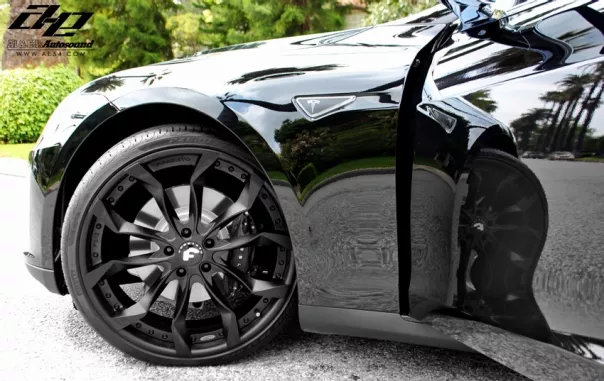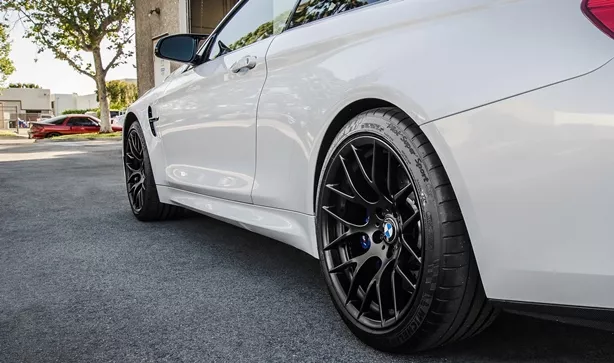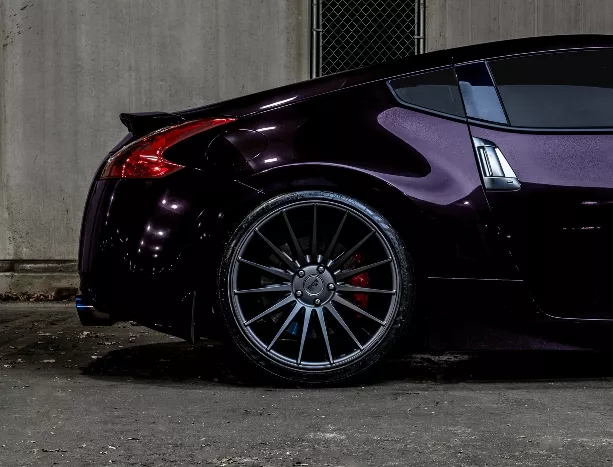Funny thing about a lot of new cars: no matter how much R&D a carmaker spends on creating functional and unique wheel designs, customers will more often than not find bigger, shinier and even edgier “shoes” to slap on to their shiny rides.
It’s part of one’s expression and individuality after all, especially when your preferred model happens to be a popular one. Placed among other car owners with the exact same ride, you’d want to stand out of course. But dialing up your car’s cool factor isn’t just about making it more visually appealing.
The wheels play a very important role in your car, as the engine’s power is transmitted through them, enabling the car to move. They also help keep the car stable as it negotiates the various twists, turns and ruts that are common in everyday driving situations. Manufacturers take great pains to design and engineer the stock wheels so that they work seamlessly with the rest of the car, so replacing them with better-looking aftermarket rims that still fall within acceptable factory specifications could prove to be a challenge. The wrong type and size of wheels can affect your car’s performance, leading to an uncomfortable ride at best, long-term damage at worst.
Here are a few useful maintenance tips to keep in mind when shopping around for your car’s new shoes, to help keep it at optimal performance while turning heads as you drive around like a boss.
1. Define your purpose first

The wheels play a very important role in your car, as the engine’s power is transmitted through them, enabling the car to move
Do you intend to use your ride exclusively for city driving? Will you be hitting the highways as well? Or maybe you foresee driving on trails every once in a while? Will you be having company or is it just you behind the wheel most of the time? Do you just want to change how your ride looks, or is it about making it perform better? How you intend to use your car throughout the duration of your ownership is a big factor in the kind of aftermarket wheels you should get.
2. Know the different brands available
You won’t want for choices in the market as far as custom wheel makers are concerned, and each of them design different characteristics into their wheels. Some of them have wheels that look best standing still, such as in a showroom. Others have a more performance-oriented nature that will be more at home on a racetrack. Still others offer more rugged wheels that are designed for offroading or increased load-bearing.
3. Decide on a size based on your particular car
While it’s often tempting to upgrade your stock rims in terms of size, bigger isn’t always better. Aside from being more expensive, bigger wheels tend to compromise ride quality, and they also require bigger tires, which is probably more than what you bargained for (unless you already factored that into your budget as well). But if you decide to go for a bigger set, take care not to go overboard. There are acceptable limits as to the dimensions of the wheel that you’re looking to mount on your steed.
>>> See related post: Why would people not want larger wheels on their cars? Click to find out.
4. Check the diameter
Mention the wheel size in everyday conversation i.e. 22” rims and chances are, you’re talking about diameter, which is the size from the edges of the bead seating area (where the tire rests on the rim) at opposite sides of the rim, excluding the wheel flanges. The bigger the diameter, the more of the wheel is visible when viewed from the side. Not too long ago, stock wheels on the average passenger car were offered in either 14”or 15” sizes; these days, 16” and 17” are the norm, with carmakers coming up with even bigger sizes for performance models.
Apart from affecting ride quality and handling, larger diameters can also potentially get you in trouble with the law. See, various systems on the car such as the driveline gearing, speedometer, brakes and stability control are designed to work with a particular wheel diameter. If the diameter is significantly altered, it can adversely affect the car’s performance. For example, speedometer readings measure wheel rotation as well as speed and rate, with the dashboard readings assumed to be using original factory specifications. A larger wheel diameter will result in a lower speedometer reading, fooling you into thinking that you’re running slower than you actually are, Naturally you’ll speed up, and before you know it, you’ve been flagged down for overspeeding.
One way to go around this is a technique called plus-sizing, going up one size in wheel diameter, two sizes going to the next size, and so on. This basically reduces the tire’s sidewall as the wheel diameter increases. The tire’s sidewall height, or aspect ratio, is expressed as a percentage of the tire’s width, and decreasing this ratio is key to maintaining the wheel’s diameter at approximately the same value. For instance, a 205mm tire width with 55% aspect ratio mounted on a 16” rim is written as 205/55/R16, and it can be replaced with 215/45/R17 as plus one, or 225/40/R18 as plus two. Reducing the sidewall to compensate for the larger tire diameter helps in making the car handle better as well.
5. Mind the width
This is the distance between bead seating areas across the rim. A range of rim widths exist for every tire size, but the actual tire width can go up by as much as an inch when going from the narrowest to the widest rim. Tires mounted on narrower rim within the specified range have a better chance of fitting a vehicle than a tire on a wider rim.

A range of rim widths exist for every tire size, but the actual tire width can go up by as much as an inch when going from the narrowest to the widest rim
A recent trend among customization enthusiasts is to take tires that are smaller than manufacturer specifications and stretching them on extremely wide wheels. Not only is this illegal, it is also dangerous. Stretching the tire’s sidewall over an excessively wide wheel diminishes the tire’s load-bearing structure (which is designed to work at a 90 degree angle to the wheel), compromising structural strength and increases the likelihood of the tire popping out of the wheel at high speed, resulting in a sudden blowout which could lead to a crash.
6. Don’t forget the offset
This is the distance from the wheel’s centerline and the part of the wheel that sits against the hub. On wheels with zero offset, the hub mounting surface is at the centerline. On a positive offset, the mounting surface is towards the wheel face, while on a negative offset the mounting surface is closer to the back side of the wheel, tending to extend more of the wheel outward.

This is the distance from the wheel’s centerline and the part of the wheel that sits against the hub
Apart from changing the look of the wheel, the type of offset also affects the way the suspension reacts every time the wheel moves. Because the wheel’s mounting hub attaches to the suspension assembly, the angle and forces transmitted between the two differ slightly, affecting the response and characteristics of the steering if the offset changes are significant. If the offset puts the wheel too close to any of the car’s bodywork, such as the fender, the frame or the suspension, the wheel isn’t going to fit.
7. Count your studs
Wheels are mounted using studs on the hub, fastened using lug nuts. Take note of the stud pattern needed on your particular vehicle. Smaller cars usually have 4, larger cars use 5, while trucks and SUVs typically have 6 or more. As if that difference wasn’t enough, they are also arranged in different diameters depending on the number of studs. This is called the Pitch Circle Diameter or PCD.
The PCD is usually expressed in numerical terms. A PCD of 5 x 116, for instance, means that there are 5 mounting holes that are spaced 116mm apart. Note that the second number is important, because a wheel with a 5-hole pattern won’t necessarily fit any wheel hub that has 5 studs; the distance between holes should be the same. The same principle applies to 4-, 6-, and 8-hole wheels.
8. Watch the load
Another thing to take into consideration is the maximum load you’ll be placing on your wheels. Different wheels have correspondingly different maximum weight load values. One way to calculate the correct weight load is to multiply the proposed maximum weight by 4. If the wheels have a load rating of 6,000 pounds, for example, then your car’s load rating will be 24,000 pounds.
9. Make sure the price is right for what you’re getting
Different aftermarket wheels have different benefits and flaws that come with the price. Splurge too much on high-end wheels and you may not have enough left for other accessories in your planned upgrade (much less for the basics like fuel and maintenance). Going for overly cheap wheels, on the other hand, might compromise quality, performance and safety on your end. Set a budget and shop diligently for the right aftermarket wheel package you can afford. To be sure, only source your aftermarket wheels from reputable dealers, as they will also be ready to offer you relevant technical advice.
See also:
Aftermarket Wheels by TSW | Custom Aftermarket wheels 101
>>> Click here to read more helpful tips for car owners











